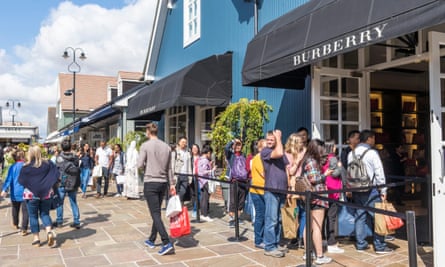“Sale: up to 60%!”, “Buy three clearance items and receive 30% off” – every shop window lining the pedestrianised boulevards and manicured flower boxes of Ashford Designer Outlet in Kent promises hefty discounts.
On a sunny afternoon in August, people are out searching for bargains on everything from school shoes and winter coats to Marks & Spencer underwear and cut-price wedding dresses.
As the cost of living crisis bites, more and more households are turning to charity shops and secondhand for unavoidable and luxury wardrobe items but there has also been an explosion in popularity for factory outlet shopping centres – AKA designer outlet villages – that offer year-round sales.
There are 37 big designer outlet centres in the UK, which between them racked up an estimated 111m visits during 2021, according to the outlet specialist Ken Gunn Consulting. Gunn says they are outperforming the high street, with sales growing at 10 times the rate of traditional retail between 2008 and 2019.
“Call it the Aldi effect,” says Tom Whittington, the director of commercial research at the property agent Savills. “There’s no longer any embarrassment about wanting, or needing, a discount.”
 View image in fullscreenAshford Designer Outlet in Kent. Photograph: Marcel/McArthurGlen
View image in fullscreenAshford Designer Outlet in Kent. Photograph: Marcel/McArthurGlen
Some outlet shops offer massive reductions but are never going to be affordable – for example, Bicester Village’s Burberry trenches and Gucci tailoring.
But most outlets blend international labels such as Hugo Boss, Kate Spade or Coach with high street brands, and you can often pick up items for just a few pounds.
Levi’s, Adidas, Guess and Nike are the most common outlet brands in Europe, and in the UK they are joined by Mountain Warehouse, Clarks, M&S, Next and the Body Shop.
McArthurGlen, which runs 26 outlet villages in Europe, including the UK’s biggest, Cheshire Oaks in Ellesmere Port, says its brands offer shoppers savings of up to 70% on recommended retail prices.
But how these outlet centres work often remains something of a mystery. Will they always save you money?
From factory seconds to excess stock
One of the UK’s first outlet centres, Clarks Village in Somerset, which arrived in 1993, was attached to the C&J Clark factory and sold seconds – shoes that had small flaws – straight from the manufacturer.
There is more scrutiny over what brands do with clothes they no longer want to sell in high street branches or online
Now, with most clothes and shoes manufactured overseas, outlets are seen as a controlled and profitable way of getting rid of excess stock, Emily Salter, a senior analyst in retail at Global Data, says.
There is more scrutiny over what brands do with clothes they no longer want to sell in their high street branches or online. “There have been stories about retailers sending stock, or online returns, to landfill or burning them, which is very damaging,” Salter says. “They now want to sell as much as possible in an outlet store, generating revenue, too.”
It is also a way of making space for new stock in their big stores, “without having half the space dedicated to sale items, which can look off-putting”.
Gunn says outlets are also increasingly seen as a way of attracting new customers, who might not usually buy from a brand at full price but may go on to do so in the future.
Shopping at outlet centres can be pot luck
Outlet shopping is not for those searching for a very specific item. “If you go just to buy a size 12 black dress, you will end up disappointed,” Gunn says.
“But if you go with £100 to spend and you’re willing to experiment, and look at brands you might have never looked at before, an outlet is a great place to find value.”
Searching the shelves and rails in Ashford, I recognise dresses from brands such as Phase Eight, Ghost and Hobbs from the spring at half-price.
The Hobbs assistant tells me that sale items are sent over to outlets once only a few sizes are left at the end of the season and the rails look a bit messy. As a result, however, certain sizes are thin on the ground. In that particular Hobbs it was hard to find anything larger than a 12.
Similarly, at Russell & Bromley, you would have been in luck if you have tiny or very large feet, where there is the biggest selection of sizes to choose from, although I did spot a pair of size 6.5s discounted from £195 to only £35.
Nike and Adidas have a wider choice of marked-down trainers, including multiple pairs of Adidas Stan Smiths in a gold colourway, which are clearly not as popular as the green, down from £75.96 to £52.
In Clarks there are children’s shoes reduced from £30 to £21, and school shoes from £50 to £35.
 View image in fullscreenShoppers at Bicester Village in Oxfordshire. Photograph: eye35.pix/Alamy
View image in fullscreenShoppers at Bicester Village in Oxfordshire. Photograph: eye35.pix/Alamy
At M&S there are recent summer ranges: “Magic Shaping” swimming costumes for £21, down from £29.50, joggers from the excellent Goodmove line for £14.50 reduced from £29.50, and a zip-up top at £10, reduced from £18.
A spokesperson for M&S says its outlets are made up of “essential and bestselling products from previous seasons that we know our customers love, so we bring them back for a discounted price at a time which is seasonally relevant, as well as excess and clearance stock.
“Prices are typically 50% off the original selling price, with further reductions of up to 70% in their clearance area.”
However, it is not immediately clear whether many of the discounts available in outlet shops are any better than what you would find from the comfort of your sofa, online.
I buy a pair of sandals for £35, reduced from £70, in Moda in Pelle but you could order the same pair with the same discount on its website.
I’ve saved on delivery, and I’ve been able to see them and try them on in person but I paid to get here: my day return train ticket from central London was almost £37, while if you are driving, you need to factor in the price of petrol. Plus, perhaps, a Starbucks coffee and lunch at Wagamama or Pizza Express if you are here for the day.
Read the labels to spot outlet-only styles
Many outlet stores create clothes and shoes that are specifically manufactured to be sold at outlet stores.
In Reiss, where there are men’s T-shirts for £16, where they usually retail for £25 to £50 full-price, I’m told that 90% of the shop stock is made for outlet stores. Signs read: “Reiss offers an outlet-exclusive collection of styles priced at 33% below equivalent garments in our brand offer. Each piece is created under the same philosophy of timeless design, quality and fit applied to our main range.” They add, however, that styling details and fabrics may differ.
 View image in fullscreenCheshire Oaks in Ellesmere Port is the biggest outlet centre in the UK. Photograph: AKP Photos/Alamy
View image in fullscreenCheshire Oaks in Ellesmere Port is the biggest outlet centre in the UK. Photograph: AKP Photos/Alamy
At Joules, popular patterned women’s wellies are on sale for £17.95, down from £49.95, and children’s coats, swimming costumes and baby clothes at better than half-price. But mixed into the rails are “new in” styles labelled as outlet-only.
“The growth of the outlet sector and the profit margins available for retailers mean it’s a big opportunity for businesses to manufacture just for outlet,” Pooja Adam, a personal stylist and wardrobe organiser for Your Style PA, says.
“Nowadays for an item to be considered as an outlet price, it has to be 30% off the original retail price. Brands tend to sell a mix of previous season stock, made for outlet and full price but consumers aren’t always aware of the difference.”
She explains that items made for outlet shops are often made from fabric offcuts or using previous seasons’ fabrics.
“They follow the designs of the previous seasons but may change the composition of the fabrics and simplify the design finishing elements such as the buttons, the lining and the collar trims … Luxury designer brands are often made in the same factories, so they tend not to compromise on manufacturing quality, and it can be hard to spot for an untrained eye. These items have been approved by the brands themselves, as they have their reputation to maintain. Look out for the letters OE, which means outlet exclusive.”
Certain types of clothes and accessories offer the best bargains
Adam’s tip for getting the “true bargains” at outlets is: “Visit outlet stores when the sales are on. It’s a gamechanger – you can get items up to 70% off.”
You can also sign up to outlet centres’ email newsletters for additional discounts.
Many shops offer further reductions if you buy more than one item. At Ashford, for example, AllSaints was offering an extra 20% for buying two pieces of clothing, and 30% for three.
 View image in fullscreenThe personal stylist Pooja Adam says visiting outlet stores when the sales are on is ‘a gamechanger’. Photograph: Roberto La Rosa/Alamy
View image in fullscreenThe personal stylist Pooja Adam says visiting outlet stores when the sales are on is ‘a gamechanger’. Photograph: Roberto La Rosa/Alamy
However, Adam also believes outlets offer the best value on specific types of clothes and accessories.
“Luxury brands have spent years crafting quality, so it is worth going into specialists for outerwear, sportswear, suiting, occasionwear and footwear. Shoes, jackets, coats, handbags and small leather goods are my most recommended categories to shop. Look out for Italian leather goods as well as 100% fabric composition in silk, wool, linen, cotton and cashmere.”
Go with a plan, and a strict budget
April Vellacott, a behavioural scientist, points out the many ways in which we can be lured into spending more than we intend.
“We usually make a day of visiting an outlet, which makes us vulnerable to what behavioural scientists call the sunk cost fallacy. If you’ve ever told yourself: ‘I’ve come all this way, so it would be a waste if I didn’t buy anything now,’ then you’ve fallen prey to this bias.”
The more expensive the original price, the better quality we assume it to beBehavioural scientist April Vellacott
Outlets also make the most of our predisposition to fear missing out.
“‘I’m not here every day,’ we tell ourselves, or we notice that there’s only one left in our size. This scarcity makes us perceive the clothes as more valuable, and increases our temptation to buy.”
Then there is the way that sales distort our perception of price.
“There’s something about discounted brands which our brains find irresistible,” Vellacott says. “The more expensive the original price, the better quality we assume it to be. We use the price as a mental shortcut to tell us how good the clothes are. Throw in heavy discounts and we find ourselves compelled to buy things we don’t want.”
Remember that it is only a bargain if you needed it in the first place.






Leave a Reply
You must be logged in to post a comment.